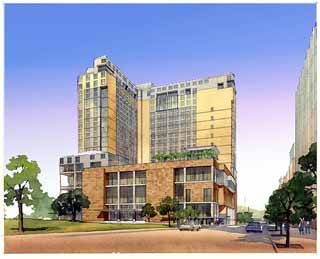Impulse Buying
Why Would the City Want to Own a Thirtysomething Hotel?
By Mike Clark-Madison, Fri., July 7, 2000

Cotera Kolar Negrete & Reed
Who says the city of Austin is hobbled by a passion for process, a paralysis of analysis, a can't-do spirit? The southeast corner of downtown must belong to some other city, because when decisions get made about the Austin Convention Center, none of those verities of local public life are on display. And so it went last week, as it took all of three days for city staff and the City Council to completely change the ground rules for the Convention Center hotel project (see "Council Watch" p.22). Those rules, you may remember, said that the hotel was to be built without a dime of public money. It's conventional wisdom in the meeting-and-convention trade that, for all but the very top tier of destination cities, if you want the big crowds and big shows and big sales- and bed-tax collections, you need a huge hotel within walking distance of the convention center. Many locals and outside experts wondered why it took Austin more than a decade, after voter approval of our Convention Center, to initiate such a hotel project. And many players -- including people who actually bid on our hotel deal -- thought it was impossible that Austin could get a project of this magnitude off the ground without a little city sugar.
And now it turns out they were right; the city's contribution to the hotel project that it awarded, this time last year, to Hilton (operator) and the Landmark Organization (developer), has gone from zero to $15 million. One would think that, when city staff went to council last week to ask for this money, they would have been in for some serious teasing. But no. After a grand total of about an hour of public discussion, the City Council gave its unanimous blessing to redirecting funds from the Convention Center's reserves to grease the Hilton/Landmark skids. (Even the deal-friendly daily, whose publisher is the president of the Downtown Austin Alliance, had called for the city to delay this decision to allow for public input.)
The city's chutzpah becomes clearer upon inspection of the devilish details. You may wonder why, if the city wasn't giving up any money, it was involved in this venture in the first place. Well, it's because the entity officially building the hotel is a city-created corporation called Austin Convention Enterprises Inc., which, being public, is allowed to issue tax-free bonds to finance the hotel, whose price tag at the moment varies from $220 million to $280 million.
It was the big institutional investors looking at buying those bonds who demanded that the city pour some sugar in the bowl. Originally, these money men demanded a 10% city contribution (so from $22 million to $28 million) paid up front, but after hard negotiation the city got it down to $15 million, payable over three years. This is money that the Convention Center, upon examination of its finances, felt it could painlessly spare.
As you may have guessed from this scenario, these are not your standard municipal bonds, but unrated, high-yield, limited-offering investments. We used to call these junk bonds, but city staff -- pointing to the sky-high demand for hotel rooms in downtown Austin, and the long list of meetings and conventions wanting to come to Austin once the Center expansion and the hotel are built -- argue that this is hardly a high-risk investment.
Which makes it not quite clear why the hotel is, by all evidence, perceived as a high-risk investment by the pension funds, mutual funds, and insurance companies who buy these kind of bonds. Partly, it's because of rising interest rates. Partly, it's because of the volatility of an economy like Austin's. Partly, it's because so many cities are spending so much money chasing the same convention business. But more than once during last week's flurry of discussions, it was suggested that the investors simply wanted the city to demonstrate its real commitment to the convention trade, in a language we can all understand.
That money is not a "subsidy," the council concluded, but an "investment." According to the tentative terms, as they currently stand, of the deal worked out with the investors, the hotel's revenues are first pledged to servicing the two sets of hotel bonds. Any surplus revenue goes to paying back the Convention Center Dept. the $15 million, with interest. (While that money is officially coming from the Center's earnings, the fund from which it's being taken is fed, at several removes, by bed-tax collections, which is why the local hotel/motel association is lukewarm about the deal, in which its members' taxes are potentially being used to help build a competing property.)

It may take 10 years (from today) to pay back the Center, but after that, any surpluses can go straight to the General Fund if the city so desires, which it very much does. (In case you're wondering, Hilton would get paid a straight fee to operate the hotel.) And in 30 years, when the bonds are paid off, the city will own the hotel. Whadda deal!
What Were We Thinking?
Now, before getting too excited, ask yourself why the city would want to own a 30-year-old hotel. Hotels have a fairly short shelf life, requiring renovation at intervals a lot more regular than 30 years. The bigger the property, the more complicated that becomes. Many convention cities, facing the aging of their keystone hotel properties, simply put up more and bigger hotels. Witness San Antonio, whose original convention hotel, also a Hilton (and about 30 years old), has long been supplanted by a Hyatt, and then a Westin, and then two huge Marriotts, and then a new 1,500-room Adam's Mark. And now the Alamo City has midwifed a deal for a Sheraton to actually be attached to its expanding convention center in Hemisfair Park.
Austin will likely never be as big a meeting market as San Antonio, but by the time the city owns our Hilton-to-be, there will probably be newer, better, and potentially even bigger convention hotels in downtown Austin, and the Hilton will likely need major reinvestment that, one might suspect, the Hilton/Landmark investors will be loath to make, if they're going to turn around and give the property up to the city. That is, if the terms of the hotel deal do not change further and encumber the city more for any needed renovations.
Having said all that, $15 million is still not that great a price to pay for safeguarding the $200-plus million the city has invested in the Convention Center itself, or for sparking the revitalization of the Convention Center district, which remains pretty dead even as the rest of downtown blows its top off. Or for bringing hundreds, maybe thousands, of new working-class jobs into a downtown whose employment base (especially after the CSC and Intel deals) becomes ever more yuppie. But this deal once again makes us wonder how well the city has thought through its convention strategy.
Consider that, by the evidence of both Austin and other convention cities, staying competitive in this market requires an almost-constant investment in expensive infrastructure that's hard to use for anything else. Consider, also, that with every city of any size in America chasing the irresistible charms of other people's money -- that left behind by tourists who make no demands on regular city services -- it's hard to conceive that the national convention market will not some day be overbuilt and headed for collapse. And consider that even the leading second-tier cities in the convention trade -- places like Denver, San Diego, Tampa, even New Orleans -- with which Austin will soon be competing have made tourism a major component of their economic strategy, which Austin, despite its lip service, has not.
Consider the fast and loose way Austin has built out its convention facilities. The original Convention Center was also built with de facto junk bonds, but that was at the bottom of the Bust, and we were lucky enough to be able to refinance once the Boom swelled our bed-tax collections. We are now doing the same thing with the hotel -- at the top of the economic cycle.
And the original Convention Center's costs were cut by leaving out the parking garage and the kitchen, both of which the city thought private investors would gladly provide given that Austin had such promise. Such was not to be, and the city had to pony up for these amenities after the fact. Now, we're doubling the center's size, at double the price of the original, and again not including parking in that price.
That was supposed to be part of the hotel deal, where the city thought private investors would gladly provide ... well, you know the rest. Now, the city is finally, after a decade, ready to spend its own money, on top of its other commitments, to build a center parking garage. (The center expansion is also, at present, being built without air conditioning, although the plan, not yet consummated, is for Austin Energy to gladly provide a central cooling plant serving both the hotel and center.)
Nor did the private sector gladly pay for a hotel that Austin needs a lot more than do the institutional investors. Is it, perhaps, time for the City Council to produce, or demand, a coherent strategic plan outlining where Austin wants to be, in the convention and tourist market, in 30 years, and stop making these decisions on the fly? After all, the less-than-orderly development of our convention trade is not really the fault of city staff, who are actually pretty damn resourceful at trying to give the council and the citizens what we want. Whatever that is. And whether or not we should want it. ![]()
Got something to say on the subject? Send a letter to the editor.








